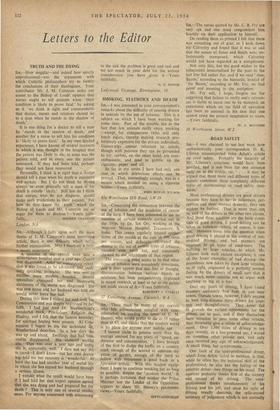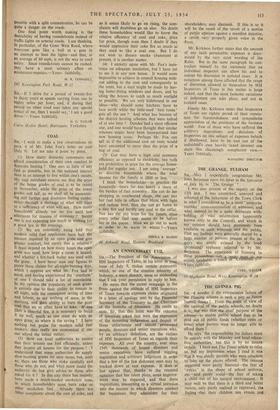• .ROAD SAFETY
SIR.--I was charmed to 'see last week how enthusiastically your correspondent D. K. Ullman misinterpreted John Arlott's article on road safety. Probably the majority of Mr. Ullman's criticisms would have been justified, bed it not been for one sentence early on hi the article, viz. ' . . . it may be argued that three main and different types of drivers contribute three completely different types of shortcomings to road safety stan- dards.'
Most professional drivers are good drivers because they have to be—in judgement, per- ception and sheer manual dexterity, they can seldom be faulted. That is more than can, be said of the drivers in the other two classes. And those three qualities are the basic essen- tials of good driving, if good driving can be taken in isolation—which, of course, it can- not. Manners come into the question when good driving is placed in the context of not- so-good driving; and bad manners are common to all types of road-users. The bullying by large vehicles, to which Mr. Ullman took such violent exception, is one of the lesser examples of bad driving—the precedence now taken by these large vehicles, as of right, originated in a perfectly normal feeling by the drivers of small cars that it was much more sensible not to argue with anything as big as a bus.
Over my years of driving, I have found manners uniformly bad both in and near towns. Outside towns, however, I defy anyone to beat long-distance lorry drivers for cour- tesy and thoughtfulness. They never fail to provide the earliest opportunity for the ptlYate car to pass, and if they themselves have occasion to pass some other vehicle, they invariably give a salute of acknowledge- ment. Over 1,500 miles of driving in ten days recently, in a km-powered car, I waved on countless other private cars, and only once received any sign of acknowledgement. A small thing, but symptomatic. . . .
One fault of the semi-professional driver, which John Arlott failed to mention, is that, while he often has the technical skill of tho professional, he also has the failing of the amateur driver—two things on his mind. The
amateur probably thinks first of the scenery and second of his driving. The semi- professional thinks simultaneously of his driving and his job, and since his style of driving usually demands the split-second accuracy of judgement which is not normally
Possible with a split concentration, he can be .quite a danger on the roads.
One final point worth making is the desirability of having roundabouts instead of traffic lights on arterial roads. I am thinking, in particular, of the Great West Road, where everyone goes like a bull at a gate in An attempt to beat the lights—and that, at an average of 60 mph, is not the way to road safety. Since roundabouts cannot be rushed, they have a most salutary effect on Recelerator-maniacs.—Yours faithfully,
M. R. TANNAHILL 342 Kensington Park Road, WA



































 Previous page
Previous page